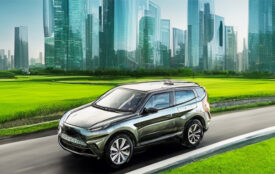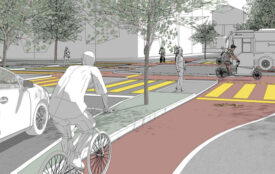Milestone: 100,000 electric cars on the streets in Denmark, Sweden, Norway and Finland
2015 was the year when the total number of electric cars in the Nordic countries passed 100,000 – a milestone which firmly establishes the role of the electric car in the Nordic car market.
In 2015, we bought 47,910 new electric cars in the Nordic countries. This is apparent from figures in the industry publication Insero Quarterly, which announces 2015 as the best-selling year ever for electric cars in the Nordic market. The impressive sales also mean that the total number of electric cars across the Nordic countries has passed 100,000.
– 2015 has been an extremely positive year for the rollout of electric cars in the Nordic market. We keep seeing new car models, and the sales figures have increased overall throughout the year. The 100,000 electric cars are also an important milestone, which proves that electric cars have now gained a solid grasp on the Nordic market, says consultant in Insero, Søren Bernt Lindegaard.
Final sprint towards the end of 2015
In the Danish market, the fourth quarter saw sales going up significantly. By year’s end, more than 4,700 electric cars had been sold – 2,500 of these in Q4 alone, which is a 280% increase compared to Q3.
– In the Danish market, Q4 was clearly influenced by the announced changes in the economic incentives. Particularly the expiration of the tax exemption on January 1st 2016 had a major impact on sales, which mere more than twice as high compared to previous quarters. As a result, we don’t expect the accelerated sales from Q4 to continue into 2016, as the economic incentives look different, Søren Bernt Lindegaard explains. Especially Tesla saw extraordinary sales in Q4, with nearly 2,000 new cars sold in the Danish market.
In Sweden, the government’s decision to allocate an additional € 14 million to their central economic incentive Supermiljöbilspremie had a positive effect on the overall sales, which had experienced a decline in Q3 of 2015. The incentive, which would otherwise have run out of funds in August 2015, is designed to offer a discount on the purchase of electric cars in Sweden.
Norwegian market success continues
The Norwegian advancement in the electric car market continued at undeterred pace in 2015, when sales increased by 77% compared to the sales levels in 2014.
– The main reason for the Norwegian market success over the past years is to be found in the economic incentives that have been implemented, such as the fact that there is no registration tax, no VAT, and no road tax for electric cars. The more convenience-related incentives, such as free charging and free driving in bus lanes, have supported the development without driving sales. Overall, the many incentives mean that electric cars have made a solid entry into the Norwegian, Søren Bernt Lindegaard explains. in 2015, more than 2,000 electric cars entered the Norwegian road network every month.
What is the forecast for 2016?
The next five years will be a transitional period for Denmark, where electric cars are incrementally introduced to the normal tax system. As a result, electric car buyers will be charged 20% of the registration tax in 2016, followed by 40%, 65% and 90% in the subsequent years. In 2020, it is expected that the tax will be fully implemented. An essential change in the new tax rules, however, is the removal of the maximum value that would justify tax reductions. Specifically, this will minimize the extra costs of the Model S Tesla, thus making it €12,000-45,000 cheaper than expected.
– We expect that the incremental introduction of electric cars to the normal tax system will cause a significant drop in electric car sales until the plug-in hybrids really introduced in Denmark. This is due to the fact that plug-in hybrids are more price competitive than pure electric cars. Conversely, it is positive that the maximum value which would justify tax reductions is removed. This will mean that more expensive electric cars such as the Tesla Model S, will remain available on the market, explains Søren Bernt Lindegaard.
In Sweden, the existing rebate system continues in 2016. However, the rebate is reduced to a maximum of €2,200 on the purchase of hybrid vehicles, while the €4,500 subsidy on the purchase of electric vehicles continues. In 2017, a new incentive system will be introduced which assigns tax reductions on purchases of cars with low CO2 emissions and, conversely, assigns taxes on purchases of cars with high CO2 emissions.
– 2016 will be an exciting year in the Nordic market, where several unknown factors can affect the rollout of electric cars. We are yet to see how big of an effect the missing tax exemption in Denmark will have on future sales. At the same time, the infrastructure continues to improve across the Nordic countries with more and more fast charging stations and we are constantly seeing new car models introduced on the market, which makes it even more attractive to be an electric car owner, Søren Bernt Lindegaard concludes. Over the next six months, it is expected that up to six new electric cars from from e.g. BMW and Volkswagen will be launched in the Nordic markets.
Insero Quarterly: The latest market insights every quarter
Are you interested in staying up to date with the development in the Nordic EV market via the latest sales statistics and the newest trends? Sign up for a free subscription to the industry publication Insero Quarterly and have it sent directly to your inbox.








